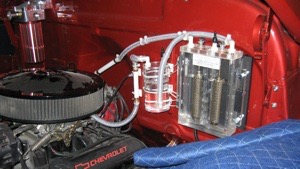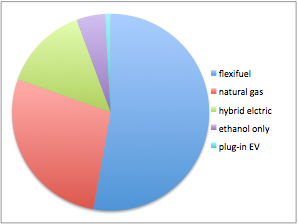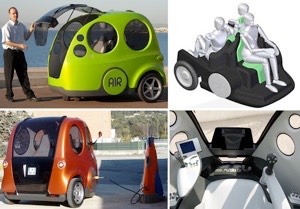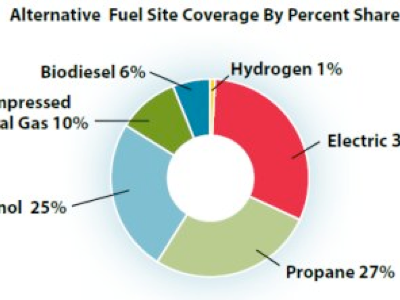essay 158 looked largely at electric and hybrid cars, but here I look at alternative fuels.
Let’s begin by the easiest transition, things we can put through our diesel / petrol engines. For terminology I introduce AFV, alternative fuel vehicle; BFV, bi-fuel vehicle; FFV, flexible fuel of vehicle; MFV, mutli-fuel vehicle. BFV and MFV assume that one of the fuels is gasoline or diesel. In a modern car the adjustment is largely electronic, perhaps supplemented by a new fuel sensor that detects the quality (composition, perhaps) and therefor the corresponding setting for the spark timing and fuel injection. A bi-fuel vehicle [BFV?] has two tanks, one fuel at a time. The FFV, the flexible fuel vehicle, (or flexfuel or flexifuel) runs on more than one fuel, in a shared tank. The wiki entry says there are a lot of these, mostly in Brazil, the US, Canada and Europe (mostly Sweden). See E85 below, which is deemed the optimal blend (though it may be that E85 simply represents a different optimum from what you think, like performance, or vague value to the customer). In most cases, flex occurs in the car name, e.g. the flexifuel Focus. Look for the yellow gas cap, wiki says. Multi-fuel cars are developing steadily and you can find examples from Ford, GM, Lotus quite easily.
It is easiest to now look at AFVs, on the assumption that some of these alternates can be used in BFVs, FFVs and MFVs.
Already we can burn various other oils, such as chip fat. This is biodiesel1. Biodiesel is made from waste veggie oil, making it cheaper than ordinary diesel and carbon neutral. I looked into sourcing it in the South West, and discovered that within spitting distance of my floating home, is a supplier. Biosulis produce biodiesel that I can put straight into my engine as a good alternative to my regular boat-yard diesel. The bio-fuel is made from recycled waste oil collected from local chip shops and restaurants and is available straight from their pump at the processing plant in Radstock. At 91p per litre, you really can’t argue with this. What’s more, if you take usable waste oil with you for them to process, there’s a litre discount of 5p.1
The Spark continues to explain that there are two conversion methods. The two-tank conversion involves running with one tank of normal diesel and one of veg oil. You use the regular diesel to start up, warm up and shut down the engine. Once the engine is warm from the mineral diesel, you swap the fuel source over to veg oil, which is also now warm and runny, and perfect for fuelling that engine.
Then there’s the Elsbett conversion. This (originally) involves changing the injection pump, glow plugs, electric pre-heating element, electric control relays and adding an aluminium plate heat exchanger in your engine. The basic result of this is to preheat the vegetable oil before ignition and change the way the fuel is sprayed into the engine, to deal with the thickness of the oil.
Costs: conversion typically £500-2000 depending on who does it. The fuel is what you pay plus 50p/litre duty. If you make it yourself, you get the first 2500 litres untaxed. If you buy it at a pump, 28p/litre or so is tax.
Hydrogen is used in a fuel-cell, but you can convert a gas engine to use this. Still hard to find supplies. In a hydrogen combustion engine, the car uses an internal combustion engine just like a gasoline-powered car, but instead of gasoline, hydrogen is the fuel source. Instead of harmful CO2 emissions, like gasoline cars produce, again, hydrogen cars produce only water vapour. Lots of automakers are currently testing hydrogen vehicles. Currently, the BMW Hydrogen 7 is perhaps the most famous; ... some tests have even shown that the car actually cleans the air around it [source: U.S. News Rankings and Reviews].2 If you’re interested, look at footnotes 3, the plus hb model and 4

, pictured.
Ethanol and E85 (bioethanol) is5 a very clean biodegradable ethanol fuel. It is made from sustainable sugarbeet and mixed with alkylate petrol to produce a benzene, aromatic and sulphur free product. Ethanol is known to lower CO2 emissions, and will, of course absorb, CO2 when grown. This product has proven to increase power in all normally aspirated engines. However, please note that fuel consumption will be increased with approximately 30% (depending on engine) if the engine is to run properly. Cold starting (-20ºC and below) can be a real problem. I didn’t find any yet in the UK, but I did find conversions6:
E85 ethanol is a flex-fuel, which means that your vehicle will be able to operate with gasoline or a hybrid mixture of 85 per cent ethanol and gasoline.
CNG (compressed natural gas) CNGas7 advertise dual fuel. CNGvehicles8 advertise a blend of CNG and diesel or on dual systems.
Propane, often delivered as LPG (liquefied petroleum gas) also called autogas, is widely available (1400 points in UK, 201510) and typically half the price of petrol (also listed10 as 50p/litre cheaper), You can calculate savings here. Many installations supply a second fuel source. It is cleaner; quoting 10 without checking, 1/120 the fine particles of ‘a diesel’ (I’d guess at a 1990s model); it makes less CO2 (which means what?). I’d guess it produces less power, but I’m struggling to find evidence to support such a comment.

Separate from what I might call minor conversions, adding a second tank (bifuel, BFV) and adjusting the engine to cope with the new fuel, we have hybrids, combining electric motors and piston power. Actually the term hybrid ought to be wider than that. wikipedia tells us that technically a Prius is not an AFV [alternative fuel vehicle], since they make a more efficient use of petroleum fuel. The same site gives us a 2014 breakdown of the 85 million converted or sold AFVs. Pie chart by me.
Looking at the very different sources and beginning with the wikipedia entry11 we might add to those I listed above:
Compressed Air (.. tec

hnology, CAT) expansion of the air drives a piston engine. Peugeot have tried this. Tata in India have made the oneCAT but it did not progress to prioduction between announcement in 2008 and 2012. The
Airpodis announced for a late 2015 launch, pictured
14
.
Dimethyl ether (DME) For a relatively small modification to a diesel engine, possibly mixed with LPG, this promises good power (a higher cetane number than petrol). it may become a second-generation biofuel. Watch this space (not here, but watch out for it).
Electric Battery - all-electric vehicles are AEVs. There are quite a few now as battery technology improves. Best seller is the Nissan Leaf, but range is still an issue. Dual technologies - hybrids in the usual sense - are closer to the user perception of need.
ammonia as fuel
Charcoal, wood gas, ammonia All from WW2, all minor contenders and all three running fairly easily on current engines but not likely to meet with approval now. Wood gas is mostly used on stationary plant. Ammonia has some Canadian success, says wikipedia [52 there], emissions being nitrogen and water vapour. It needs compression, probably; it is perhaps no more toxic in the raw state than petrol and diesel. It may be useful if ammonia is locally available.
From where I switch (ha) to discuss sources incompatible with those above. I don’t think these could be BFVs.
Hydrogen
In a fuel-cell vehicle, the hydrogen is used to generate electricity that's then used to power electric motors. So, rather than running strictly off of battery power alone, a hydrogen-powered car uses a fuel cell to generate its own electricity. In a chemical process within the fuel cell, hydrogen and oxygen are combined to create electricity, and the only byproduct of this process is water vapour. The Honda FCX Clarity uses this technology and is currently being leased to drivers in southern California. 2
BMW’s CE and its H2R prototype were of the combustion engine type, earlier. The fuel cell is more efficient (define and cite). Some think this is the future for vehicles, cars especially.
Liquid nitrogen (LN2). It warms up and expands. Better than compressed air. A 93 gallon tank of LN2 equates to 13 gallons of gasoline. [Looking for ‘LN2 cars’ directs to Lincoln carparks]. I found this existing vehicle. Stated advantage of this fuel is that the production process, taking N2 from the air, would locally reduce CO2 and SO2 - by how much would depend on volumes.
Solar power to generate electricity. As a sole source this won’t drive anything heavy as yet, but as a supplementary source it is already enough to power ancillary demands. Obviously more so in Australia than Britain.
DJS 20140303
Steam is not for internal combustion, but external. See 161.
1 http://www.thespark.co.uk/read-the-spark/green/bio-your-engine.html
2 http://auto.howstuffworks.com/fuel-efficiency/hybrid-technology/10-alternative-fuels-on-the-road.htm
4 https://www.hydrolectricpower.com
5 http://www.aspenfuel.co.uk/products/environmental-fuels/ethanol-blends/r-e85-super-clean-85-grade/
6 http://www.ehow.co.uk/how_7494668_convert-e85-ethanol.html
8 http://www.cngvehicles.co.uk
9 http://www.environmentallyfriendlymotoring.co.uk/fuels/
10 http://www.drivelpg.co.uk/about-autogas/
11 http://en.wikipedia.org/wiki/Alternative_fuel_vehicle
12 http://automotivedigest.com/2014/03/finding-the-roi-for-alternative-fuel-and-green-technology/ top picture and note the typing eror, ....fules.jpg
13 http://news.discovery.com/autos/fuel-and-alternative-fuel-technologies/sunlight-to-seawater-10-ways-to-power-your-car-141002.htm This did not load well for me and I lost the pictures.
14 http://www.rushlane.com/tata-airpod-unveil-2015-12143096.html
15 http://www.autoexpress.co.uk/nissan/leaf/88344/nissan-leaf-to-get-sharp-new-look-and-range-boost
16 http://www.washington.edu/alumni/columns/dec97/car2.html alternatives to petrol. Says little.
17
18
19
To explore:
cetane number
measures of power yield
material specific energy (MJ/kg) energy density (MJ/litre)
coal 24 varies
diesel / fuel oil 48 35.8
gasoline (petrol) 44.4 32.4
wood 16.2 varies
LPG 46.4 26
lead-acid battery 0.17 0.56
LN2 around 97 Wh/kg, = 0.35 MJ/kg (figures from differing wiki pages don’t agree; I found 203 WH/kg = 173Whr/litre => (it says) up to 70Wh usable, making the 97 wh/kg believable in good conditions)
CAT (air)
